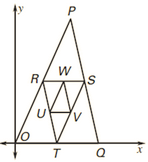In the diagram, O is lacated at (0,0), U is located at (7,6),
and V is located at (11,6).
Assume that R, S, T, U, V, and W are midpoints.

\(1)\\ \begin{array}{|rcl|rcl|rcl|} \hline R &=& U + \dfrac{TR}{2} & \dfrac{TR}{2}+T &=& U & T &=& \dfrac{Q}{2} \\ && & \dfrac{TR}{2}+\dfrac{Q}{2} &=& U \\ && & \dfrac{TR}{2} &=& U-\dfrac{Q}{2} \\ R &=& U + U-\dfrac{Q}{2} \\ \mathbf{R} &=& \mathbf{2U-\dfrac{Q}{2}} \\ \hline S &=& T+TS & T+\dfrac{TS}{2} &=& V & T &=& \dfrac{Q}{2} \\ & & & \dfrac{Q}{2}+\dfrac{TS}{2} &=& V \quad | \quad *2 \\ & & & Q+TS &=& 2V \\ & & & TS &=& 2V-Q \\ S &=& \dfrac{Q}{2} + 2V-Q \\ \mathbf{S} &=& \mathbf{2V-\dfrac{Q}{2}} \\ \hline \end{array}\)
\(2)\\ \begin{array}{|rcl|rcl|rcl|} \hline && &P &=& S + \dfrac{QP}{2} & QP &=& 2(S-Q) \\ && &P &=& S + (S-Q) \\ && &P &=& 2S-Q & S&=&2V-\dfrac{Q}{2} \\ && &P &=& 4V-Q-Q \\ && &\mathbf{P} &=& \mathbf{4V-2Q} \\ \hline && &P &=& 2R & R&=&2U-\dfrac{Q}{2} \\ && &\mathbf{P} &=& \mathbf{4U-Q} \\ P= 4U-Q &=& 4V-2Q \\ 4U-Q &=& 4V-2Q \\ \mathbf{ Q }&=& \mathbf{4V-4U} \\ \hline \end{array} \\ 3)\\ \begin{array}{|rcl|rcl|rcl|} \hline W&=& \dfrac{1}{2}( R+S )& R&=&2U-\dfrac{Q}{2} & S&=&2V-\dfrac{Q}{2} \\ W&=& \dfrac{1}{2}( 2U-\dfrac{Q}{2}+2V-\dfrac{Q}{2} ) \\ W&=& \dfrac{1}{2}( 2U+2V-Q ) \\ \mathbf{ W }&=& \mathbf{U+V-\dfrac{Q}{2}} \\ \hline \end{array}\)
\(\text{Summary:}\quad Q=4V-4U \\ \begin{array}{|rcll|} \hline T&=& \dfrac{Q}{2} \\ R&=& 2U-\dfrac{Q}{2} \\ S&=& 2V-\dfrac{Q}{2} \\ W&=& U+V-\dfrac{Q}{2} \\ P&=& 4U-Q \\ \hline \end{array}\)
Substitute \(Q\):
\(\begin{array}{|rcll|} \hline T &=& -2U+2V \\ Q &=& -4U+4V \\ R &=& 4U-2V \\ S &=& 2U \\ W &=& 3U-V \\ P &=& 8U-4V \\ \hline \end{array}\)
Substitute \(U(7,6)\) and \(V(11,6)\):
\(\begin{array}{|rcll|} \hline \mathbf{T} &=& -2(7,6)+2(11,6) = (-14+22, -12+12) =\mathbf{(8,0)}\\ \mathbf{Q} &=& -4(7,6)+4(11,6) = (-28+44, -24+24) =\mathbf{(16,0)}\\ \mathbf{R} &=& 4(7,6)-2(11,6) = (28-22, 24-12) =\mathbf{(6,12)}\\ \mathbf{S} &=& 2(7,6) = \mathbf{(14, 12)} \\ \mathbf{W} &=& 3(7,6)-(11,6) = (21-11, 18-6) =\mathbf{(10,12)}\\ \mathbf{P} &=& 8(7,6)-4(11,6) = (56-44, 48-24) =\mathbf{(12,24)}\\ \hline \end{array}\)
